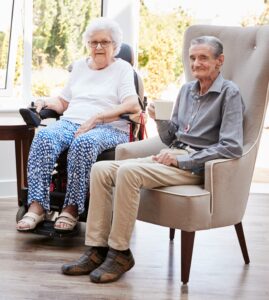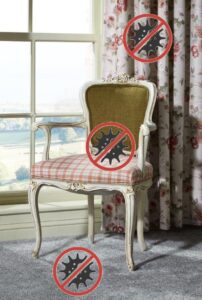 “Having interiors suitable for a care environment is one of the key elements to achieving an Outstanding level of care provision.”
“Having interiors suitable for a care environment is one of the key elements to achieving an Outstanding level of care provision.”
These are the words of Issac Theophilos, author of “Outstanding Care Homes”, highlighting the growing recognition of the role that interiors play in creating a safe, comfortable environment that residents are proud to call home.
So, with investment in interiors firmly back on the agenda as we emerge from the pandemic, what best practices should operators follow and what should they avoid?
DO:
Create a strategy
When chairs, beds or flooring need replacing, it is tempting to go for the quickest and cheapest solution. But a quick fix approach doesn’t lead to the best decisions in terms of care or design, which is why many homes end up with a selection of furniture, furnishings and flooring of varying designs and standards of compliance.
 If possible, take a step back to properly consider your care, compliance and commercial goals, including the conceptual design (‘look and feel’) you wish to achieve. Make sure that inclusivity is at very the heart of your considerations, across your entire space – including gardens. This will dictate how you proceed with planning, procurement and project management, so that you follow a consistent approach when you next replace individual items or undertake refurbishments.
If possible, take a step back to properly consider your care, compliance and commercial goals, including the conceptual design (‘look and feel’) you wish to achieve. Make sure that inclusivity is at very the heart of your considerations, across your entire space – including gardens. This will dictate how you proceed with planning, procurement and project management, so that you follow a consistent approach when you next replace individual items or undertake refurbishments.
Put care needs first
How will the care needs of your residents and service users be supported by your interior design decisions?
 Durability and hygiene are typically top priority. Upholstery must be commercial-grade and waterproof, and chairs will sometimes need to have reinforced frames. Posture support, comfort and pressure relief are also key criteria for seating. In fact, residents who are chair-bound are at a higher risk of developing pressure sores than those who are bed-bound, due to the smaller surface area. Wheelchair cut-outs on tables, both indoors and outdoors, can help to promote inclusivity.
Durability and hygiene are typically top priority. Upholstery must be commercial-grade and waterproof, and chairs will sometimes need to have reinforced frames. Posture support, comfort and pressure relief are also key criteria for seating. In fact, residents who are chair-bound are at a higher risk of developing pressure sores than those who are bed-bound, due to the smaller surface area. Wheelchair cut-outs on tables, both indoors and outdoors, can help to promote inclusivity.
In dementia care, there are many ways that layout can be adapted and specific design elements incorporated to promote wellbeing and independence. These include positioning beds opposite doors for those with reduced peripheral vision; using contrasting colours for walls and flooring to minimise confusion; having large handles on bedroom furniture; and avoiding busy patterns for upholstery.
From a safety perspective, anti-slip vinyl is often chosen for flooring, and we would recommend that rounded corners are specified as standard for furniture, regardless of setting.
Engage residents in decisions
One of the Care Quality Commission’s five questions asked of the services they inspect is ‘Are they caring?’, and it makes specific reference to involving residents.
 Given the pivotal role that interiors play in making the environment homely, this is certainly an area in which homes can engage everyone at an appropriate stage in decision-making. Once you are down to a shortlist of suitable design options, you could present them to residents and invite views. This collaborative approach is a great way of showing them that you are listening properly to their input, and that they still have an influence over their surroundings.
Given the pivotal role that interiors play in making the environment homely, this is certainly an area in which homes can engage everyone at an appropriate stage in decision-making. Once you are down to a shortlist of suitable design options, you could present them to residents and invite views. This collaborative approach is a great way of showing them that you are listening properly to their input, and that they still have an influence over their surroundings.
 Build hygiene into the fabric of your home
Build hygiene into the fabric of your home
When a care home looks to tighten up infection control measures, they tend to focus on cleaning routines. However, a better starting point is the inherent germ resistance of interiors. Anti-microbial textiles can make a significant contribution here. Take-up of such products hasn’t been as widespread over the last few years as you might expect – especially for flooring and curtains –presumably due to concerns that high performance would compromise style. This misconception is changing as design options continue to broaden, and we are seeing anti-microbial fabrics and surfaces specified in environments that are both practical and stylish.
DON’T:
 Rely on high-street retailers:
Rely on high-street retailers:
Specifying furniture that is designed for domestic usage is impractical at best, and dangerous at worst.
Daniel Steel, Registered Cluster Manager at Hft, recently procured some new sofas for Beech Spinney care home in Ironbridge, Shropshire, which supports adults with learning disabilities. He explains:
“Although using high-street retailers is very common in our sector, we’ve found that the furniture simply isn’t fit-for-purpose. It isn’t built to withstand the demands of the care environment. We’ve had sofas last six months. In many cases, they won’t be flame-retardant to the required level. If they do meet infection control standards, it is at the expense of comfort and style.”
Hft opted for specialist furniture and found that the price point was actually less than the retail equivalents, with a better range of mix-and-match options to tailor the care quality and style to their precise needs – and with a shorter lead time.
Lose sight of homeliness
Although care provision and infection control remain at the forefront of prospective residents’ and families’ minds, it is the comfort and all-important ‘home from home’ atmosphere that makes an environment appealing. These days it’s perfectly possible to make choices that tick all the boxes – durable and hygienic yet comfortable and homely.
 There are many simple ways to create homeliness and personalise surroundings, for instance by taking inspiration from residents’ past lives to shape a design theme. In one home for ex-RAF servicemen and women, unique features such as RAF gold buttons were incorporated into some of the armchairs upholstered in the ‘RAF Blue’ faux leather. A home situated on the coast weaved seaside-related features into its interiors, including a ‘Sweetshop’ area.
There are many simple ways to create homeliness and personalise surroundings, for instance by taking inspiration from residents’ past lives to shape a design theme. In one home for ex-RAF servicemen and women, unique features such as RAF gold buttons were incorporated into some of the armchairs upholstered in the ‘RAF Blue’ faux leather. A home situated on the coast weaved seaside-related features into its interiors, including a ‘Sweetshop’ area.
Indoor plants (biophilia) can contribute greatly to boosting wellbeing, and memory boxes or cabinets used to display photographs and other objects of sentimental value can be enormously beneficial in triggering happy memories and enabling experiences to be shared with other residents and carers.
Overlook carers’ wellbeing
 Equipment and interiors also contribute to the safety, suitability and attractiveness of care homes as workplaces, with operators under legal and moral obligations to deliver the right support to their staff.
Equipment and interiors also contribute to the safety, suitability and attractiveness of care homes as workplaces, with operators under legal and moral obligations to deliver the right support to their staff.
In such a physical role, mechanical aids for moving and handling tasks and appropriate training for manual handling are both imperative to avoid the risk of injury. These also help to complete caring tasks more efficiently so that carers can focus on interacting socially with residents. Safe and effective guidance on cleaning routines (especially to avoid the most common causes of injury – slips and trips) and handling chemicals are vital to prevent accidents.
There is also an increasing focus – quite rightly – on staff facilities. Do staff have somewhere they can relax and recharge during their breaks? Showing carers that their wellbeing is a priority too can make all the difference not only to care standards but to an operator’s success in recruiting and retaining staff.
Undermine your compliance efforts
Just as furniture from retail outlets is not adequately fire-rated, the same holds true for wallpaper and flooring. If a home lets residents bring in their own furniture, this too will increase the number of domestic-grade items and undermine compliance efforts – not only in terms of fire risk but also hygiene. Many homes use fire-retardant sprays on curtains but these will become ineffective after a few washes at disinfection temperature; curtain fabric should be fire rated to commercial standards and anti-microbial by design.
IN SUMMARY:
These are just some best practices to follow, and pitfalls to avoid, when designing and fitting out each space within your care home. Interiors are a reflection of your commitment to protecting residents and staff while creating a comfortable and homely environment. Giving your choices due consideration now will reap benefits in the long-term.

